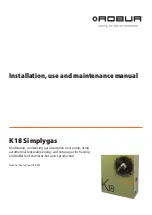
Features and technical data
8
1
temperature).
B. Low load: active heat pump in modulation and auxiliary boil-
er off.
C. Average/high load: active heat pump at full power and ac-
tive auxiliary boiler in modulation (integration).
D. High load: maximum power for the operating condition to
be reached quicker (integration).
E. Very high load: heat pump out of the operating limits and
auxiliary boiler that autonomously covers the design load
(replacement at low ambient temperature).
Figure 1.2
Armonia control system diagram
Tj [°C]
outdoor temperature
PLRh(Tj) [%] plant partial load ratio at outdoor temperature Tj
A
Heat pump off. Active auxiliary boiler in modulation
B
Active heat pump in modulation. Auxiliary boiler off
C
Active heat pump at full power. Active auxiliary boiler in modulation
D
Active heat pump at full power. Active auxiliary boiler at full power
E
Heat pump off. Active auxiliary boiler at full power
100%
0%
T j
20°C
A
B
C
D
E
PLRh(Tj) [%]
In the presence of a minimal thermal demand (scenario A), the
minimum power of the heat pump could still be excessive in
comparison to the demand. In this case it may be advantageous
to use only the auxiliary boiler (replacement mode), if this has
adequate modulation capacity.
In the presence of low thermal demand (scenario B), only the
heat pump will be active in modulation mode, whereas the aux-
iliary boiler will be off.
As the thermal demand increases (scenario C), the heat pump
reaches full power and, if the thermal load still cannot be ful-
filled, it will activate the auxiliary boiler, which (if the specific
model used allows it) will run in modulation mode. The heat
pump will still remain active and at full power, and therefore the
power of the auxiliary boiler will be added to that of the heat
pump (integration mode).
When the thermal demand is high (scenario D), for example
while the system reaches operating conditions, the heat pump
and auxiliary boiler will run at maximum power, reducing the
necessary time for the operating conditions to be reached and
ensuring the optimal comfort even in harsher environmental
conditions.
If the heating system design require the water tem-
perature to be higher than the maximum that can be
dispensed by the heat pump, in high thermal demand
conditions (scenario E), the auxiliary boiler can be acti-
vated as its replacement. In this type of application the
maximum thermal load of the building must be at most
equal to the power of the auxiliary boiler and not to the
sum of the power of the two appliances (replacement
mode).
The auxiliary boiler can therefore be operated in four ways (see
also Paragraph 5.3.6
p. 41):
▶
Inactive (the auxiliary boiler does not intervene in any way).
▶
Emergency (the auxiliary boiler is only activated when there
is an alarm on the heat pump module).
▶
Integration (active auxiliary boiler as necessary for integra-
tion of the heat output of the heat pump module, scenarios
B, C, and D).
▶
Integration and replacement (just like in the integration
mode, with the addition that in particular environmental
conditions, the heat pump can be deactivated and only the
auxiliary boiler operates, scenarios A and E).
1.1.6
DHW production
The K18 Simplygas appliance can autonomously manage the
DHW buffer tank charging function if a temperature probe in the
buffer tank (available as OSND004 optional) is properly connect-
ed and configured.
The DHW production modes available in this scenario are limit-
ed to basic functionality. For more comprehensive management
of DHW production, the use of the OQLT021 system controller is
recommended.
If the unit manages the production of DHW directly, any request
contact for the DHW service has the function of switching be-
tween two different setpoints of the DHW buffer tank tempera-
ture, which can be set by means of appropriate parameters.
In the presence of the OQLT021 system controller, the
management of DHW production, with the control of the
relevant temperature probe, must be carried out by the
controller itself, and not by the K18 Simplygas appliance.























